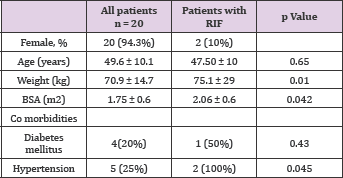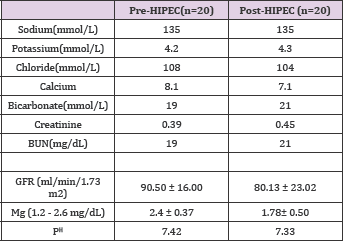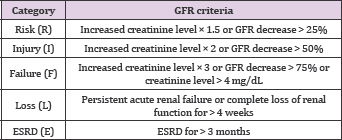Impact Factor : 0.548
- NLM ID: 101723284
- OCoLC: 999826537
- LCCN: 2017202541
Aslan Bilge*1, Aydin Feray2 and Gungor Tayfun3
Received: March 19, 2018; Published: April 09, 2018
*Corresponding author: Aslan Bilge, Anesthesiologist, Zekai Tahir Burak Training and Research, Hospital, Anesthesia Clinic Department, Talatpaja Bulvari, 06050, Ankara, Turkey
DOI: 10.26717/BJSTR.2018.03.000936
Background
a) Objective: Hyperthermia intraperitoneal chemoprophylaxis (HIPEC) is a treatment of peritoneal carcinomatosis with potential iatrogenic [1-4]. This study was designed to define the effects of HIPEC on renal functions, electrolytes, nefropaty.
b) Methods: We retrospectively reviewed the perioperative care of 20 patients. After cytoreductive surgery (CS), residual tumors were not present in all cases, or were less than or equal to 3 mm (measured in size). Cisplatin 50mg/m2 plus doxorubicin 15mg/m2 was used [1-8]. This is a retrospective study evaluating patients receiving cisplatin with doxorubicin during HIPEC [9,10]. Comorbidities and effects of nephrotoxic drugs were found. Renal function parameters, including serum magnesium levels, were also collected on preoperative and postoperative creatinine levels and on days 1, 5 and 21 posts HIPEC. Perioperative urine output (UO) was also recorded.
d) Findings: 20 patients were identified. Based on the RIFLE classification, patients (2.0%) developed acute renal damage (AKI) with HIPEC after cisplatin. The other patient had renal damage. Comparable mean creatinine levels were observed at baseline and on postoperative 21th day after HIPEC (p> 0.05). The incidence of hypomagnesaemia increased to 10% (p = 0.02) on the 5th day and to 5% on the 21th day (p>0.05) after HIPEC.
e) Conclusion: Nephrotoxicity and permanent renal dysfunction may rarely occur in cisplatin therapy with HIPEC. We should closely monitor postoperative Mg levels in patients who have undergone HIPEC administration. Doxsorubicin may have cardiotoxic side effects.
Keywords: Peritoneal Carcinomatosis; HIPEC; Cisplatin; Doxorubicin; Electrolytes
Abbreviations: HIPEC: Hyperthermia Intraperitoneal Chemoprophylaxis; CS: Cytoreductive Surgery; UO: Urine Output; AKI: Acute Renal Damage
All patients received HIPEC during general anesthesia. Standard induction was 8 mg/kg Pentothal, 1 |i/kg fentanyl, and 6 mg/kg rocuronium intravenously. In the case of all patients in the place were opened as MAC: 1 sevolurane and 40% Oxygen + 60% nitrogen was given. TOF and BIS moniterisations were standardized. After debalking operation, HIPEC was performed using a 0.9% isotonic solution of cisplatin + doxarubicin for 40 minutes at 41-42°C. All patients underwent open perfusion. Metabolic, electrolyte and hemodynamic changes were noted during chemo-fusion, as well as postoperative metabolic, electrolyte and hemodynamic changes recorded on days 3, 5 and 21.
From January 2010 to January 2016, 20 patients were treated. Chemofusion with 0.9% isotonic resulted in transient significant hyponatremia and metabolic acidosis. While major morbidity occurred in 5% of patients, there was no mortality for 6 months. .Chemical interaction with doxorubicin led to mild hepatic toxicity but not significant. Hipomagnesemia was found to be significant when serum magnesium levels were below 0.7 mm / L. On the 2nd day after operation in one patient in V4, V5, V6 T negative. T negativity improved within a few days (Tables 1-3). Troponin I and CK-MB never elevated in this patient. Transient hypotension developed in two patients. Doxsorubicin may have cardiotoxic side effects.
Table 1: Demographic Datas.

Table 2: Electrolytes data.

Table 3: RIFLE classification.

GFR: Glomerular Filtration Rate; UO: Urine Output; ESRD: End-Stage Renal Disease.
Cytoreduction with HIPEC using high dose cisplatin and leads to manageable metabolic and electrolyte disturbances, rarely nephrotoxicity and frequent mild hepatic toxicity without noticable impact on postoperative morbidity, Doxorubicin may have cardiotoxic side effects.


